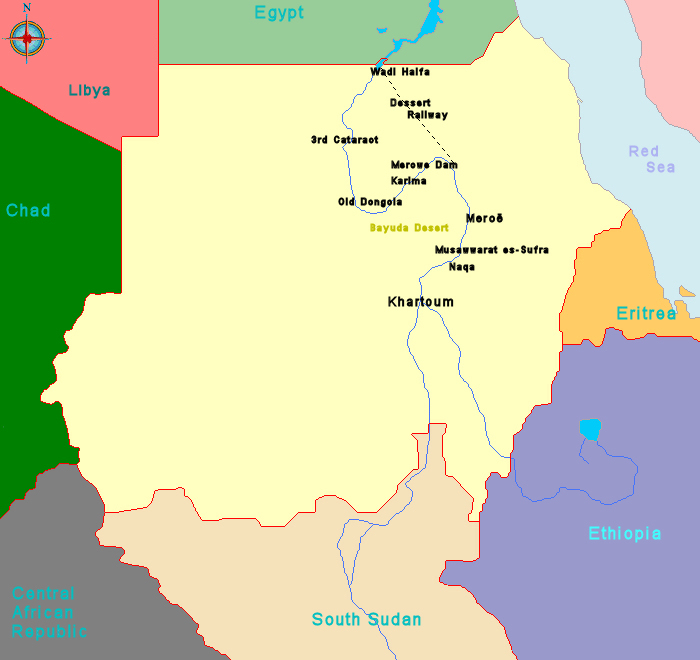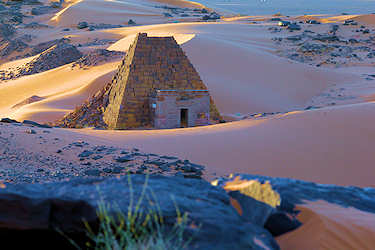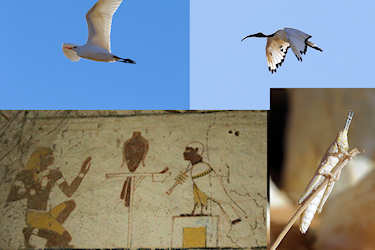Sudan

Historie
By the eighth millennium BC, people of a Neolithic culture had settled into a sedentary way of life
there in fortified mud-brick villages, where they supplemented hunting and fishing on the Nile with grain gathering
and cattle herding.
During the fifth millennium BC migrations from the drying Sahara brought new neolithic people into the Nile Valley
along with agriculture. The population that resulted from this cultural and genetic mixing developed social hierarchy
over the next centuries become the Kingdom of Kush (with the capital at Kerma) at 1700 BC.
After King Kashta ("the Kushite") invaded Egypt in the 8th century BC, the Kushite kings ruled as Pharaohs of
the Twenty-fifth dynasty of Egypt for nearly 100 years. Of the Nubian kings of this era, Taharqa is perhaps the
best known. Taharqa, was crowned king in Memphis in c.690. Taharqa ruled over both Nubia and Egypt, restored
Egyptian temples at Karnak, and built new temples and pyramids in Nubia, before being driven from Egypt by the
Assyrians
MeroŽ was the southern capital of the Napata/Meroitic Kingdom, that spanned the period
c. 800 BC ó c. 350 AD. The base of this flourishing kingdom was due to a strong iron industry, and international
trade involving India and China. The Kingdom began to fade as a power by the 1st or 2nd century AD, sapped by the war
with the Roman province of Egypt and the decline of its traditional industries. Christianity began to gain over the
old phaoronic religion and by the mid-sixth century AD the Kingdom was dissolved.
Nubia was divided into three kingdoms; Nobatia, extending from the First to the Third Cataracts, with its capital
at Faras; Makuria from the Third to the Sixth Cataracts, centered on Old Dongola and Alwa,
streching to the borders with Axum with its capital at Soba on the Blue Nile. The rise of the Mamaluks
in Egypt in the 13th century marked the end for Nubia's Christian kings. Over a period of 200 years they sent a series
of military expeditions into an increasing weak and fragmented Nubia.
In 1821, the Ottoman ruler of Egypt, Muhammad Ali, had invaded and conquered northern Sudan. The Egyptian
authorities made significant improvements to the Sudanese infrastructure (mainly in the north), especially with regard
to irrigation and cotton production. During the 1870s, European initiatives against the slave trade caused an
economic crisis in Northern Sudan, precipitating the rise of Mahdist forces. Muhammad Ahmad ibn Abd Allah,
the Mahdi (Guided One), offered to the ansars (His Followers) and those who surrendered to him a
choice between adopting Islam or being killed. The Mahdiyah (Mahdist regime) imposed traditional
Sharia Islamic laws. From his announcement of the Mahdiyya in June 1881 until the fall of Khartoum in January
1885, Muhammad Ahmad led a successful military campaign against the Turco-Egyptian government of the Sudan
In the 1890s, the British sought to re-establish their control over Sudan, once more officially in the name of the
Egyptian Khedive, but in actuality treating the country as a British colony. From 1924 until independence in 1956,
the British had a policy of running Sudan as two essentially separate territories, the north (Muslim) and south
(Christian).
The First Sudanese Civil War was a conflict from 1955 to 1972 between the northern part of Sudan and the
southern Sudan region that demanded representation and more regional autonomy. Half a million people died over the
17 years of war. However, the agreement that ended the First Sudanese Civil War's fighting in 1972 failed to
completely dispel the tensions that had originally caused it, leading to a reigniting of the north-south conflict
during the Second Sudanese Civil War, which lasted from 1983 to 2005. The period between 1955 and 2005 is
thus sometimes considered to be a single conflict with an eleven-year ceasefire that separates two violent phases.
As agreeded in the 2005-Peace Treaty in January 2011 referendum on independence for Southern Sudan was held,
and the South voted overwhelmingly to secede later that year as the Republic of South Sudan, with its capital at
Juba and Kiir Mayardit as its first president
I did visit Sudan in november 2013
These are the places i have seen
Khartoum
Old Dongola
3rd Cataract of the Nile
Wadi Halfa
Dessert Railway
Merowe Dam
Karima
Bayuda Desert
MeroŽ
Musawwarat es-Sufra
Naqa
Please let me know when you're having questions.
i would be pleased to help you.
Things to do and other tips

This illustrate's my memories of Sudan:
An undisturbed sunset at the Pyramids of MeroŽ.
See my "Things to do" pages for more pictures.
When i'am visiting a country i like to be prepared;
So i know something about the Country and i can plan the things to visit.
That's why i 'm reading books;looking at travel maps etc.
See my
"Things to read" pages for Books/Maps about
Sudan
Special Items
